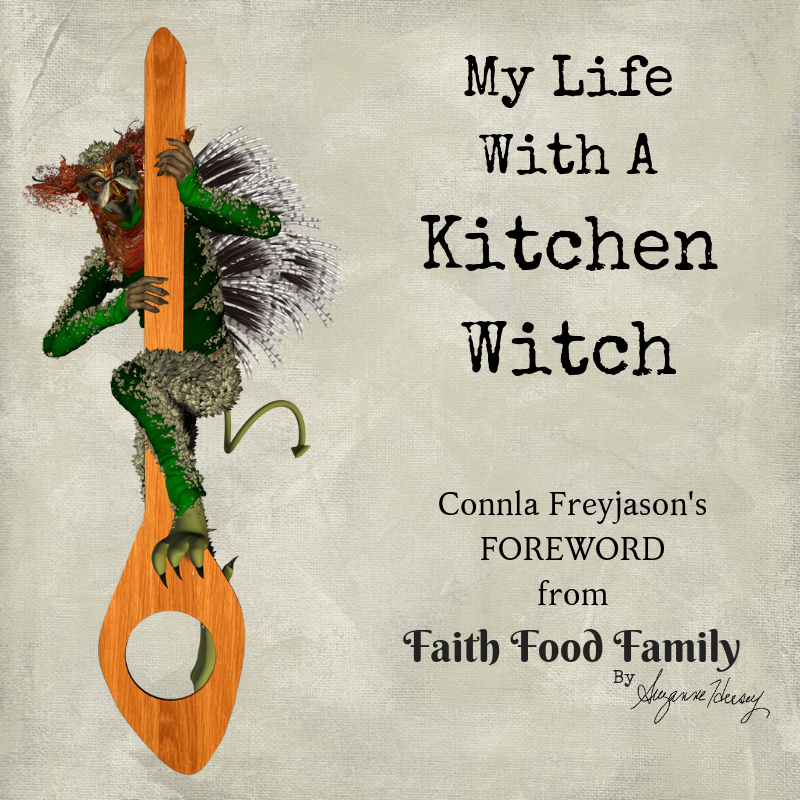My Life With A Kitchen Witch

This is the Foreword, by Norse Witch and author Connla Freyjason, for Faith Food Family by Suzanne Hersey, which will be released by Iaconagraphy Press in Fall, 2018.
I always knew food was magical. I love to eat. Eating may, in fact, be my favorite activity as a human being, beyond learning new things. If only food had as few calories as knowledge; if only our “belt capacity” was as invisible as our brain capacity! I have loved food all my life; loved the smell of it as much as the taste. Vacation-planning always involves meal-plans first, and holidays are all about the food. Then I met her….
I first met Suzanne while in the process of putting together a healthier diet and herbal program for a sick relative. Clearly, she knew as much about food for healing as I did about Chinese herbal medicine. Her brain–just the way she thinks–amazed me. It wasn’t until quite some time after that, when she finally cooked for me, that I finally realized food wasn’t just magic, it was magick. Food isn’t just something that can heal, it is a thing that can nurture. Suzanne Hersey taught me one of the most important lessons I’ve ever learned as a magickal practitioner: food is love.
I don’t just mean that in some namby-pamby, “things that are cool to say in a cookbook” kind of way. No, it’s far deeper than that. Since the beginning of human history, food has meant fellowship. The search for food was what led hunter gatherers to strike out from their local habitat, and seek out new hunting grounds; to explore, and, as they did so, to form tribes. Food–the hunger and the need–was the foundation of the first religious expressions of humankind as well, painted on cave walls in Lascaux, France, and across rock faces in Borhuslan, Sweden. Food was offered to the Gods in rivers and in lakes, and we still have the five-thousand-year-old charred apples, their pips still intact, at Alvastra, Sweden, to prove it. There, along the shores of Lake Vattern, two disparate cultures–the Linear Pottery Culture and the Pitted Ware Culture–came together, with the help of food, to form a new culture: Funnelbeaker Culture. Wherever two cultures met, throughout history, food was usually the first element of cultural diffusion that occurred, melding and blending the people who shared those tables into individual, unified new cultures. That’s what I mean when I say food is love; I’m pretty sure, even without necessarily meaning to do so, it’s what Suzanne Hersey means, too.
Faith is the other thing I’ve learned deeply from my time with Suzanne. Like food, it is a thing that brings people together. Unfortunately, too often, it is likewise a thing that quickly tears people apart. Either/or dichotomies breed screaming matches that can quickly turn into wars, if we aren’t careful. Yet, again, when you add food to the mix, something wonderful happens. Instead of either/or, one suddenly finds themselves in a both/and buffet! For faith can be like an incredible ingredient added to a stew: too much pepper can spoil the whole pot, but just the right amount, and something wonderful happens! And like a stew or a stir fry (because, hey, I’m half Chinese!), one can never have too many different ingredients. Variety, they say, is the spice of life; it most definitely should be the soul of religion.
Ultimately, faith revolves around the same sense of safety as family, or, at least, it should. Faith isn’t about “my God is bigger than your God”, or “I’m Catholic, and you’re Heathen, and never the twain shall meet.” No, it’s about a certain kind of knowing that there is something “out there” that will catch us when we fall. Note, when; not if, because we’re all human, and falling is inevitable eventually. A sense of family comes equipped with that same sense of knowing. That applies not only to blood-relations, but to anyone and everyone in your life who you know, without a shadow of a doubt, has your back, when the chips are down or the odds are stacked against you. Family knows no race, no culture, no gender; it simply speaks, acts, does, and catches you when you fall, from the heart. I learned that from Suzanne, too.
In our household, the phrase “Faith Food Family” has consequently quickly come to replace that outmoded and much-abused Heathen mantra of “Faith Folk Family”. “Folk” can argue and get caught up on all the wrong things; “Food”, on the other hand, can bring people together as can few other things. Food is an invitation to sit down at our table; it’s an offering of love, as I said before. Food doesn’t judge the color of a person’s skin, or who a person gives their heart to, or what gender they identify as, or what God they worship, it simply says “be welcome at my hearth.”
Hearth-culture is an ages-old tradition, evidenced by the ancient fireplaces and hearths discovered worldwide. The very concept calls to mind images of families and friends gathered around the fire, sharing food, stories, and time. Of course, in our modern world, not every home has a fireplace, yet every home has a kitchen. From the dorm room mini-fridge and microwave, to the largest palatial dream-kitchen, the kitchen has become the twenty-first century center of hearth-culture. There, leaning on cabinets and stirring pots on stoves, friends gather to become family, and families gather to become friends. Yummy smells of cooking food and baking cookies invite us in, and then permeate throughout the household, turning the whole place into one large, hygge-filled hearth-zone.
That’s another thing I learned from Suzanne: hygge. It’s actually a Danish and Norwegian word, for a feeling of comfort, warmth, and contentment. Etymologically, it comes to us from a Danish word meaning “to give courage, comfort, joy”. Of course, Suzanne didn’t always use that word for the magick that she simply intuitively does; calling it hygge came later. However, it lies at the heart of her entire practice; her entire way of life. Like the Iron Age Scandinavians, she lives her Kitchen Witchery every day in every way, and not just in the kitchen. Imparting that courage, comfort, and joy is what it means in the Havamal, when it says:
Fair health to those who give (literally: givers)!
A guest has come in,
Where shall they sit?
Too hasty is he who would earn his fame by the sword.
Fire, the need of the man who has come,
On frozen knees.
Meat and clothes this man needs,
This one who has travelled over the mountains.Water is needed by the dinner-guest,
Also dinner napkins (literally: towels) and hearty welcomes;
Goodness, instead of ill-behavior, if such can be accomplished;
Words, as well as silence.—Havamal 2, 3, & 4, Connla Freyjason Translation
Within that silence lies the “hug” that is a hygge-filled home, and that “hug” is the source of a sort of magick that it is easy enough to learn, but more than difficult to describe. Suzanne “gives great hugs”. This book is one of them. Like the Kitchen Witch who wrote it, it is a multicultural mix of love, food, faith, and, most of all, magick.

